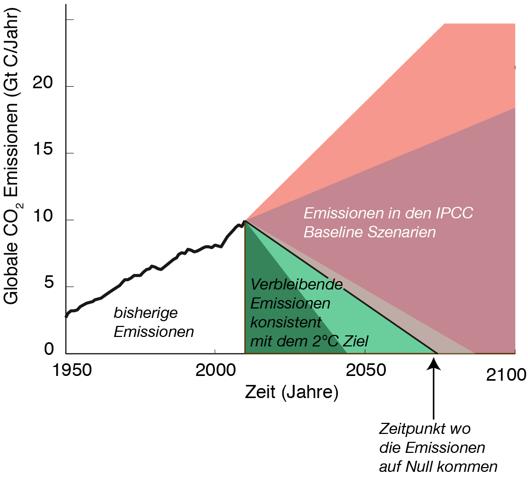Vision zero: why we have to reduce our CO2 emissions to zero
Every climate target gives us a permissible emissions budget. Achieving the two-degree Celsius goal will require complete decarbonisation of the economy within the next 50 years. It will not be enough for us to make existing processes more efficient – a profound change in nearly all aspects of our society is required.
Next Wednesday the third "Klimarunde" will take place. We titled the event “Vision zero”, as we will discuss the possible ways that could lead us to a CO2-neutral society. In this blog post, I would like to discuss the scientific background of this vision.
A budget of global CO2 emissions
Research in the past decade has shown clearly that we have only a limited amount of CO2 emissions available in order to reach a specific climate target. This amount is determined by the climate sensitivity and the capacity of forests and oceans to take up CO2 from the atmosphere, i.e., the strength of the carbon sinks. The climate sensitivity describes how much the Earth warms when the CO2 concentration in the atmosphere increases. The strength of the carbon sinks determines how much atmospheric CO2 increases for a given amount of emissions.
We can obtain a zeroth order estimate of this permissible budget by assuming that the forests and oceans continue to absorb around half of the CO2 emissions (as they used to in the past) and that the Earth gets about three degrees Celsius warmer when CO2 concentrations in the atmosphere double compared to pre-industrial times. With a number of simplifying assumptions (see box), one arrives for the two-degree target at a permissible budget of around 800 gigatonnes of carbon (Gt C). This is 800 billion tonnes C, or around 3,000 billion tonnes of CO2. Simulations using state-of-the-art climate models that also allow for feedback mechanisms between the climate and the carbon cycle result in a very similar number. We can envision these permissible emissions as a pie that we are allowed to eat, but must last until the end of the century. At first glance the pie seems to be sufficient – in fact it is actually twice as large as it would be if these CO2 sinks had not helped us with the removal of atmospheric CO2.
More than half already eaten up
But if we consider how much CO2 humankind has emitted already in the past 150 years by burning fossil fuels and cutting down forests, then unfortunately less than half of the pie is left. In concrete terms, we have already consumed more than 500 Gt C from this budget, leaving us only around 300 Gt C [1]. If we start from today's emissions (around 10 Gt C per year) and their trends, then we will have used up the entire budget in less than three decades [2]. After this, we can allow no net additional CO2 into the atmosphere, otherwise we greatly increase the probability that we will overshoot the two-degree target.

This means that from the second half of this century onward, global CO2 emissions have to be reduced to zero. As a result, we should not focus on achieving a low CO2 future, we need to achieve a CO2-free future.
Which reduction rate is realistic?
A rapid reduction path would make it possible for future generations to still emit CO2, but such rapid reduction paths are very difficult to achieve. A strong lock-in effect results from our heavy investment in a global fossil-driven infrastructure over the past decades – and we are still investing in it today. When we consider that the average running time of fossil fuel-fired power plants is several decades, it is clear that it is not easy for new energy sources to crack this market, even if prices are becoming competitive (see Tony Patt’s blog). In addition, wind turbines, solar panels and the entire associated infrastructure have to be built and installed first, which requires building new factories, training new specialists and making substantial investments. This takes time. Judging from the speed with which new technologies diffused into market in the past, it will be very difficult to achieve a reduction rate of more than six percent per year.
Vision zero
Even if we follow this optimistic reduction path, we will still have exhausted the global emission budget before the end of the century. When we allocate emission rights to individual countries, we also need to take into consideration that developed countries have proportionally less emissions available in the future due to their past emissions [3]. And if we do not manage to reverse the global CO2 emissions trend soon, the limits on the reduction rates implies that we can achieve the two-degree target only with negative emissions, i.e., we would need a net removal of CO2 from the atmosphere. While this is technologically possible today [5], it is very expensive and it remains unclear where the CO2 would be stored.
Conclusion
For Switzerland, I see the need to achieve a full decarbonisation of our society in the second half of this century [4].We have nearly 50 years to implement this process; but it is a long journey and one that goes beyond 2030, as it has to continue until emissions are reduced to zero.
Acknowledgements: I thank Professor Reto Knutti for his valuable input.
Further information
[1] Due to considerable uncertainties, 500 Gt C was deliberately chosen as a conservative estimate. IPCC estimates total anthropogenic emissions at 555 Gt C.
IPCC AR5, WG1, Summary for Policy Maker, writes: “From 1750 to 2011, CO2 emissions from fossil fuel combustion and cement production have released 375 [345 to 405] Gt C into the atmosphere, while deforestation and other land use changes are estimated to have released 180 [100 to 260] Gt C. This has resulted in cumulative anthropogenic emissions of 555 [470 to 640] Gt C.”
[2] CO2 meter: external pageLinkcall_made
[3] Article on CO2 pie and its allocation
[4] Article on the topic vision zero
[5] Climeworks: external pageCO2 Capture Plantcall_made
About the author
A simple way to estimate the CO2 budget
The warming of the Earth, ∆T, can be estimated as a first approximation by the product of the climate sensitivity, g, and the change in the atmospheric CO2 concentration, ∆CO2atm, i.e.,
∆T = g · ∆CO2atm (1)
The change in atmospheric CO2 depends on the cumulative emissions and the strength of carbon sinks. If we assume that the strength of these sinks is constant, then a simple estimation follows:
∆CO2atm ≈ fair · ∫Ffoss (2)
in which fair represents the 'airborne fraction', i.e., the proportion of emissions that remain in the atmosphere, whereas 1-fair represents the amount absorbed by the ocean and forests. When we combine the two equations, we get:
∆T ≈ g · fair · ∫Ffoss (3)
i.e., the warming of the Earth is directly proportional to the cumulative emissions. The proportionality factor is defined by the product of the climate sensitivity and the airborne fraction. The first is approx. 3°C per doubling of the pre-industrial CO2 concentrations, i.e., around 3°C per 580 Gt C, while the airborne fraction remained fairly constant over the past decades at around 50%. If we now want to determine the emissions budget for a specific climate target, then we simply have to solve (3) for the cumulative emissions, i.e.,
∫Ffoss ≈ ∆T /(g · fair) (4)
For the 2°C target, this results in:
∫Ffoss ≈ 2°C /(3°/580 Gt C · 0.5) = 780 Gt C.
The uncertainties are considerable. Also I made a number of simplifying assumptions. First, I neglected that the airborne fraction increases with rising emissions, while the climate sensitivity, or more accurately the resulting radiative forcing, decreases with rising atmospheric CO2 concentrations. In addition, I used the equilibrium climate sensitivity instead of the more appropriate transient climate sensitivity. Finally I neglected the role of methane, nitrous oxide and other non CO2 greenhouse gases. In other words: This derivation is meant for illustrating the concept and shall not be used for a precise calculation of the budget.
For a more in-depth discussion and more precise calculation, please see MacDougall and Friedlingstein, (2015) (Journal of Climate, external pageDOIcall_made), as well as this external pagelinkcall_made.

